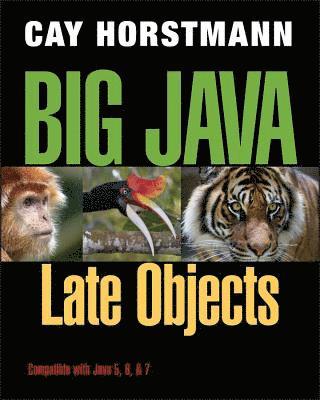
- Format
- Häftad (Paperback / softback)
- Språk
- Engelska
- Antal sidor
- 1056
- Utgivningsdatum
- 2012-02-20
- Upplaga
- 1
- Förlag
- John Wiley & Sons Inc
- Illustratör/Fotograf
- Illustrations
- Illustrationer
- Illustrations
- Dimensioner
- 254 x 203 x 38 mm
- Vikt
- Antal komponenter
- 1
- ISBN
- 9781118087886
- 2430 g
Big Java
Late Objects
Kundrecensioner
Fler böcker av Cay S Horstmann
-
Core Java for the Impatient
Cay S Horstmann
-
Core Java, Volume I
Cay S Horstmann
-
Core Java, Volume II
Cay S Horstmann
-
Scala for the Impatient
Cay S Horstmann
Övrig information
Cay S. Horstmann is a Professor of Computer Science in the Department of Computer Science at San Jose State University. He is an experienced professional programmer and was Vice President and Chief Technology Officer for Preview Systems, Inc. He is also a consultant for major corporations, universities, and organizations on Java, C++, Windows, and Internet programming. Horstmann is the author of many successful professional and academic books, including Big C++, C++ for Everyone, Big Java, and Big Java: Late Objects all with John Wiley & Sons, Inc.
Innehållsförteckning
Preface v Special Features xxvi Chapter 1 INTRODUCTION 1 1.1 Computer Programs 2 1.2 The Anatomy of a Computer 3 1.3 The Java Programming Language 5 1.4 Becoming Familiar with Your Programming Environment 8 1.5 Analyzing Your First Program 12 1.6 Errors 15 1.7 Problem Solving: Algorithm Design 16 Chapter 2 FUNDAMENTAL DATA TYPES 29 2.1 Variables 30 2.2 Arithmetic 41 2.3 Input and Output 48 2.4 Problem Solving: First Do It By Hand 57 2.5 Strings 59 Chapter 3 DECISIONS 81 3.1 The if Statement 82 3.2 Comparing Numbers and Strings 88 3.3 Multiple Alternatives 96 3.4 Nested Branches 100 3.5 Problem Solving: Flowcharts 105 3.6 Problem Solving: Test Cases 108 3.7 Boolean Variables and Operators 111 3.8 Application: Input Validation 116 Chapter 4 LOOPS 139 4.1 The while Loop 140 4.2 Problem Solving: Hand-Tracing 147 4.3 The for Loop 150 4.4 The do Loop 156 4.5 Application: Processing Sentinel Values 158 4.6 Problem Solving: Storyboards 162 4.7 Common Loop algorithms 165 4.8 Nested Loops 172 4.9 Application: Random Numbers and Simulations 176 Chapter 5 METHODS 201 5.1 Methods as Black Boxes 202 5.2 Implementing Methods 204 5.3 Parameter Passing 207 5.4 Return Values 210 5.5 Methods Without Return Values 214 5.6 Problem Solving: Reusable Methods 215 5.7 Problem Solving: Stepwise Refinement 218 5.8 Variable Scope 225 5.9 Recursive Methods (Optional) 228 Chapter 6 ARRAYS AND ARRAY LISTS 249 6.1 Arrays 250 6.2 The Enhanced for Loop 257 6.3 Common Array Algorithms 258 6.4 Using Arrays with Methods 268 6.5 Problem Solving: Adapting Algorithms 272 6.6 Problem Solving: Discovering Algorithms by Manipulating Physical Objects 279 6.7 Two-Dimensional Arrays 282 6.8 Array Lists 289 Chapter 7 INPUT/OUTPUT AND EXCEPTION HANDLING 317 7.1 Reading and Writing Text files 318 7.2 Text Input and Output 323 7.3 Command Line Arguments 330 7.4 Exception Handling 337 7.5 Application: Handling Input Errors 347 Chapter 8 OBJECTS AND CLASSES 361 8.1 Object-Oriented Programming 362 8.2 Implementing a Simple Class 364 8.3 Specifying the Public Interface of a Class 367 8.4 Designing the Data representation 371 8.5 Implementing Instance Methods 372 8.6 Constructors 375 8.7 Testing a Class 380 8.8 Problem Solving: Tracing Objects 386 8.9 Problem Solving: Patterns for Object Data 388 8.10 Object References 395 8.11 Static Variables and Methods 400 Chapter 9 INHERITANCE AND INTERFACES 415 9.1 Inheritance Hierarchies 416 9.2 Implementing Subclasses 420 9.3 Overriding Methods 424 9.4 Polymorphism 430 9.5 Object: The Cosmic Superclass 441 9.6 Interface Types 448 Chapter 10 GRAPHICAL USER INTERFACES 465 10.1 Frame Windows 466 10.2 Events and Event Handling 470 10.3 Processing Text Input 481 10.4 Creating Drawings 487 Chapter 11 ADVANCED USER INTERFACES 507 11.1 Layout Management 508 11.2 Choices 510 11.3 Menus 521 11.4 Exploring the Swing Documentation 528 11.5 Using Timer events for Animations 533 11.6 Mouse Events 536 Chapter 12 OBJECT-ORIENTED DESIGN 549 12.1 Classes and Their Responsibilities 550 12.2 Relationships Between Classes 554 12.3 Application: Printing an Invoice 562 12.4 Packages 574 Chapter 13 RECURSION 585 13.1 Triangle Numbers Revisited 586 13.2 Problem Solving: Thinking Recursively 590 13.3 Recursive Helper Methods 594 13.4 The Efficiency of Recursion 596 13.5 Permutations 601 13.6 Mutual Recursion 606 13.7 Backtracking 612 Chapter 14 SORTING AND SEARCHING 627 14.1 Selection Sort 628 14.2 Profiling the Selection Sort Algorithm 631 14.3 Analyzing the Performance of the Selection Sort Algorithm 634 14.4 Merge Sort 639 14.5 Analyzing the Merge Sort Algorithm 642 14.6 Searching 646 14.7 Problem Solving: Estimating the Running Time o
Du kanske gillar
-
Careless People
Sarah Wynn-Williams
Inbunden -
Clean Code
Robert Martin
Häftad -
The Tech Coup
Marietje Schaake
Inbunden
